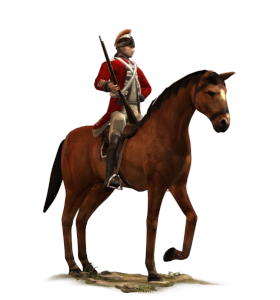Difference between revisions of "Light Dragoons (ETW Unit)"
Tango12345 (talk | contribs) (sorting out) |
(→Unit Details) |
||
| Line 8: | Line 8: | ||
Historically, dragoons lost their role as mounted infantry over the course of the 18th Century, and became another kind of light cavalry, although they retained the name. The officers and men welcomed the change to a role that had a higher social status (and usually better | Historically, dragoons lost their role as mounted infantry over the course of the 18th Century, and became another kind of light cavalry, although they retained the name. The officers and men welcomed the change to a role that had a higher social status (and usually better | ||
| − | == | + | ==Details== |
| − | Dragoons are ranged cavalry. They may engage effectively in both firefights and melee, although they are not as strong as specialized units in either area. Dragoons have the options to skirmish, where they will attempt to | + | Light Dragoons are ranged cavalry. They may engage effectively in both firefights and melee, although they are not as strong as specialized units in either area. Dragoons have excellent stamina, allowing them to escape from or reach situations not possible for other units. Dragoons have the options to skirmish, where they will attempt to harass the enemy while staying out of range, and dismount. Dismounting dragoons reduces their speed and melee capabilities, but improves their resistance to enemy fire, as well as improving their ability to deal damage with their muskets. Versatile in their uses, dragoons can be used to add firepower support to a point on the battlefield quickly and are equally useful in the conventional cavalry roles of breaking enemy morale and chasing down routing troops. In more recent versions of Empire: Total War, light dragoons can even fire their carbines while charging into the fray, giving them an extra edge against their opponents. |
| − | + | Dragoons do hold the disadvantage of having relatively poor morale. Most notably, they suffer very high penalties for withdrawing from combat. It is not uncommon for a dragoon retreat to turn into a rout despite minimal casualties. | |
| − | On top of this, | + | Dragoons are unable to form the wedge or diamond formations for most factions, with the British being an exception. |
| − | + | On top of this, dragoons receive bonuses in repression of local populations, and are a useful addition to militia forces in areas of unrest as a peacekeeping force. However, they are more expensive to recruit and maintain than militia and provincial cavalry. | |
==Factions== | ==Factions== | ||
Revision as of 08:48, 21 February 2012
Overview
Their horses are for mobility, not for any shock value in battle and are often little better than nags and ponies, rather than decent warhorses. In battle, this is unimportant as light dragoons dismount and form a skirmish line to harass an enemy and screen the main body of their own army. The main weapon carried is a shortened musket, originally termed a “dragon” or dragoon (like “rifle”, the term came to be applied to the man carrying the gun). This is not an accurate weapon, but is no worse than any other smooth-bore. Light dragoons are also useful in suppressing riotous and rebellious civilians. Their horses give them strategic mobility, allowing them to police large areas effectively and come to the aid of the local authorities. Historically, dragoons lost their role as mounted infantry over the course of the 18th Century, and became another kind of light cavalry, although they retained the name. The officers and men welcomed the change to a role that had a higher social status (and usually better
Details
Light Dragoons are ranged cavalry. They may engage effectively in both firefights and melee, although they are not as strong as specialized units in either area. Dragoons have excellent stamina, allowing them to escape from or reach situations not possible for other units. Dragoons have the options to skirmish, where they will attempt to harass the enemy while staying out of range, and dismount. Dismounting dragoons reduces their speed and melee capabilities, but improves their resistance to enemy fire, as well as improving their ability to deal damage with their muskets. Versatile in their uses, dragoons can be used to add firepower support to a point on the battlefield quickly and are equally useful in the conventional cavalry roles of breaking enemy morale and chasing down routing troops. In more recent versions of Empire: Total War, light dragoons can even fire their carbines while charging into the fray, giving them an extra edge against their opponents. Dragoons do hold the disadvantage of having relatively poor morale. Most notably, they suffer very high penalties for withdrawing from combat. It is not uncommon for a dragoon retreat to turn into a rout despite minimal casualties. Dragoons are unable to form the wedge or diamond formations for most factions, with the British being an exception. On top of this, dragoons receive bonuses in repression of local populations, and are a useful addition to militia forces in areas of unrest as a peacekeeping force. However, they are more expensive to recruit and maintain than militia and provincial cavalry.
